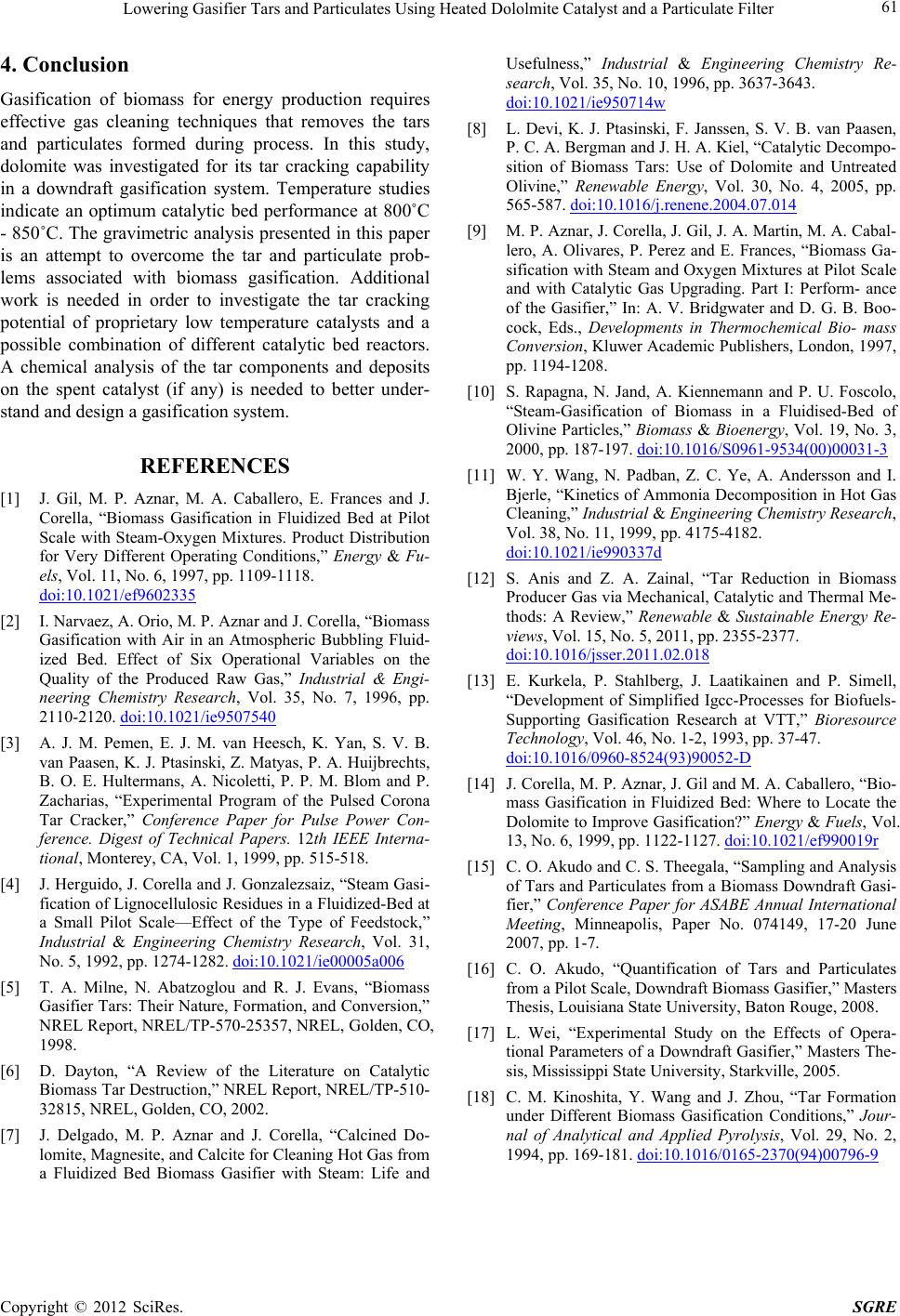
Lowering Gasifier Tars and Particulates Using Heated Dololmite Catalyst and a Particulate Filter 61
4. Conclusion
Gasification of biomass for energy production requires
effective gas cleaning techniques that removes the tars
and particulates formed during process. In this study,
dolomite was investigated for its tar cracking capability
in a downdraft gasification system. Temperature studies
indicate an optimum catalytic bed performance at 800˚C
- 850˚C. The gravimetric analysis presented in this p aper
is an attempt to overcome the tar and particulate prob-
lems associated with biomass gasification. Additional
work is needed in order to investigate the tar cracking
potential of proprietary low temperature catalysts and a
possible combination of different catalytic bed reactors.
A chemical analysis of the tar components and deposits
on the spent catalyst (if any) is needed to better under-
stand and design a gasification system.
REFERENCES
[1] J. Gil, M. P. Aznar, M. A. Caballero, E. Frances and J.
Corella, “Biomass Gasification in Fluidized Bed at Pilot
Scale with Steam-Oxygen Mixtures. Product Distribution
for Very Different Operating Conditions,” Energy & Fu-
els, Vol. 11, No. 6, 1997, pp. 1109-1118.
doi:10.1021/ef9602335
[2] I. Narvaez, A. Orio, M. P. Aznar and J. Corella, “Biomass
Gasification with Air in an Atmospheric Bubbling Fluid-
ized Bed. Effect of Six Operational Variables on the
Quality of the Produced Raw Gas,” Industrial & Engi-
neering Chemistry Research, Vol. 35, No. 7, 1996, pp.
2110-2120. doi:10.1021/ie9507540
[3] A. J. M. Pemen, E. J. M. van Heesch, K. Yan, S. V. B.
van Paasen, K. J. Ptasinski, Z. Matyas, P. A. Huijbrechts,
B. O. E. Hultermans, A. Nicoletti, P. P. M. Blom and P.
Zacharias, “Experimental Program of the Pulsed Corona
Tar Cracker,” Conference Paper for Pulse Power Con-
ference. Digest of Technical Papers. 12th IEEE Interna-
tional, Monterey, CA, Vol. 1, 1999, pp. 515-518.
[4] J. Herguido, J. Corella and J. Gonzalezsaiz, “Steam Gasi-
fication of Lignocellulosic Residues in a Fluidized-Bed at
a Small Pilot Scale—Effect of the Type of Feedstock,”
Industrial & Engineering Chemistry Research, Vol. 31,
No. 5, 1992, pp. 1274-1282. doi:10.1021/ie00005a006
[5] T. A. Milne, N. Abatzoglou and R. J. Evans, “Biomass
Gasifier Tars: Their Nature, Formation, and Conversion,”
NREL Report, NREL/TP-570-25357, NREL, Golden, CO,
1998.
[6] D. Dayton, “A Review of the Literature on Catalytic
Biomass Tar Destruction,” NREL Report, NREL/TP-510-
32815, NREL, Golden, CO, 2002.
[7] J. Delgado, M. P. Aznar and J. Corella, “Calcined Do-
lomite, Magnesite, and Calcite for Cleaning Hot Gas from
a Fluidized Bed Biomass Gasifier with Steam: Life and
Usefulness,” Industrial & Engineering Chemistry Re-
search, Vol. 35, No. 10, 1996, pp. 3637-3643.
doi:10.1021/ie950714w
[8] L. Devi, K. J. Ptasinski, F. Janssen, S. V. B. van Paasen,
P. C. A. Bergman and J. H. A. Kiel, “Catalytic Decompo-
sition of Biomass Tars: Use of Dolomite and Untreated
Olivine,” Renewable Energy, Vol. 30, No. 4, 2005, pp.
565-587. doi:10.1016/j.renene.2004.07.014
[9] M. P. Aznar, J. Corella, J. Gil, J. A. Martin, M. A. Cabal-
lero, A. Olivares, P. Perez and E. Frances, “Biomass Ga-
sification with Steam and Oxygen Mixtures at Pilot Scale
and with Catalytic Gas Upgrading. Part I: Perform- ance
of the Gasifier,” In: A. V. Bridgwater and D. G. B. Boo-
cock, Eds., Developments in Thermochemical Bio- mass
Conversion, Kluwer Academic Publishers, London, 1997,
pp. 1194-1208.
[10] S. Rapagna, N. Jand, A. Kiennemann and P. U. Foscolo,
“Steam-Gasification of Biomass in a Fluidised-Bed of
Olivine Particles,” Biomass & Bioenergy, Vol. 19, No. 3,
2000, pp. 187-197. doi:10.1016/S0961-9534(00)00031-3
[11] W. Y. Wang, N. Padban, Z. C. Ye, A. Andersson and I.
Bjerle, “Kinetics of Ammonia Decomposition in Hot Gas
Cleaning,” Industrial & Engineering Chemistry Research,
Vol. 38, No. 11, 1999, pp. 4175-4182.
doi:10.1021/ie990337d
[12] S. Anis and Z. A. Zainal, “Tar Reduction in Biomass
Producer Gas via Mechanical, Catalytic and Thermal Me-
thods: A Review,” Renewable & Sustainable Energy Re-
views, Vol. 15, No. 5, 2011, pp. 2355-2377.
doi:10.1016/jsser.2011.02.018
[13] E. Kurkela, P. Stahlberg, J. Laatikainen and P. Simell,
“Development of Simplified Igcc-Processes for Biofuels-
Supporting Gasification Research at VTT,” Bioresource
Technology, Vol. 46, No. 1-2, 1993, pp. 37-47.
doi:10.1016/0960-8524(93)90052-D
[14] J. Corella, M. P. Aznar, J. Gil and M. A. Caballero, “Bio-
mass Gasification in Fluidized Bed: Where to Locate the
Dolomite to Improve Gasification?” Energy & Fuels, Vol.
13, No. 6, 1999, pp. 1122-1127. doi:10.1021/ef990019r
[15] C. O. Akudo and C. S. Theegala, “Sampling and Analysis
of Tars and Particulates from a Biomass Downdraft Gasi-
fier,” Conference Paper for ASABE Annual International
Meeting, Minneapolis, Paper No. 074149, 17-20 June
2007, pp. 1-7.
[16] C. O. Akudo, “Quantification of Tars and Particulates
from a Pilot Scale, Downdraft Biomass Gasifier,” Masters
Thesis, Louisiana State University, Baton Rouge, 2008.
[17] L. Wei, “Experimental Study on the Effects of Opera-
tional Parame ters of a Downdraft Gasifier,” Masters The-
sis, Mississippi State University, Starkville, 2005.
[18] C. M. Kinoshita, Y. Wang and J. Zhou, “Tar Formation
under Different Biomass Gasification Conditions,” Jour-
nal of Analytical and Applied Pyrolysis, Vol. 29, No. 2,
1994, pp. 169-181. doi:10.1016/0165-2370(94)00796-9
Copyright © 2012 SciRes. SGRE